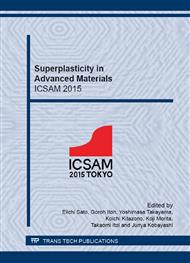p.379
p.385
p.392
p.398
p.404
p.410
p.416
p.422
p.428
Superplastic Behavior of a Cu-Cr-Zr Alloy Subjected to ECAP
Abstract:
A Cu-0.87%Cr-0.06%Zr alloy was subjected to equal channel angular pressing (ECAP) at a temperature of 400 °C up to a total strain of ~ 12. This processing produced ultra-fine grained (UFG) structure with an average grain size of 0.6 μm and an average dislocation density of ~4×1014 m-2. Tensile tests were carried out in the temperature interval 450 – 650 °C at strain rates ranging from 2.8´10-4 to 0.55 s-1. The alloy exhibits superplastic behavior in the temperature interval 550 – 600 °C at strain rate over 5.5´10-3 s-1. The highest elongation-to-failure of ~300% was obtained at a temperature of 575 °C and a strain rate of 2.8´10-3 s-1 with the corresponding strain rate sensitivity of 0.32. It was shown the superplastic flow at the optimum conditions leads to limited grain growth in the gauge section. The grain size increases from 0.6 μm to 0.87 μm after testing, while dislocation density decreases insignificantly to ~1014 m-2.
Info:
Periodical:
Pages:
404-409
Citation:
Online since:
January 2016
Authors:
Price:
Сopyright:
© 2016 Trans Tech Publications Ltd. All Rights Reserved
Share:
Citation:


